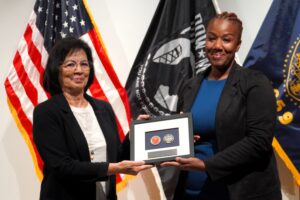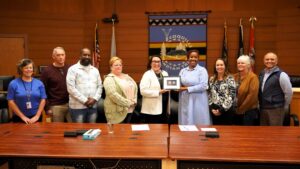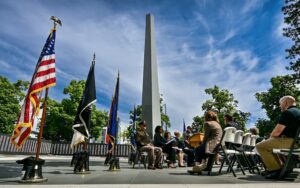![]()
In honor of Hispanic Heritage Month (Sept. 15 through Oct. 15), the Oregon Department of Veterans’ Affairs will be sharing stories from the state’s and nation’s military and cultural history, including profiling individual Hispanic American veterans and family members.
There are an estimated 560,000 Hispanic Americans living in Oregon today — and more than 60 million — across the United States. They represent a rich and diverse cultural heritage — as well as a proud history of service in our nation’s military — dating to some of our earliest conflicts.
Spanish-American War
April-December 1898

Several thousand Hispanic volunteers, mostly from the southwest, fought with distinction in the U.S. Army during the Spanish-American War in 1898. Capt. Maximiliano Luna and others comprised a portion of the famous 1st U.S. Volunteer Cavalry — better known as “The Rough Riders” — which fought in Cuba under the command of Col. Theodore Roosevelt, who had resigned his position as assistant secretary of the Navy to join the volunteer cavalry.
The Rough Riders saw action at Las Guásimas, a village three miles north of Siboney on the way to Santiago and became the stuff of legend for their courage during the Battle of San Juan Hill. Sgt. George Armijo, another Rough Rider, later became a member of Congress and served on the school board and city council in his hometown of Santa Fe, New Mexico.
World War I
1914-1918

In May 1917, two months after legislation granting United States citizenship to individuals born in Puerto Rico was signed into law, and one month after the United States entered World War I, a unit of volunteer soldiers was transferred to the Panama Canal Zone.
Another Act of Congress was passed in 1917 to obtain needed manpower for the war effort, and the Hispanic community was eager to serve its country. They included both native-born service members, mostly of Mexican descent, and new immigrants from Latin America, Mexico and Spain. In June 1920, the unit was redesignated as the 65th Infantry Regiment and served as the U.S. military’s last segregated unit.
Hispanic soldiers like Nicholas Lucero and Marcelino Serna served with great distinction and were among the most decorated service members from WWI. Lucero received the French Croix de Guerre (roughly the equivalent of the U.S. Bronze or Silver Star) during World War I for destroying two German machine gun nests and maintaining constant fire for three hours, while Serna became the first Hispanic to be awarded the Distinguished Service Cross, the second-highest military decoration of the U.S. Armed Forces.
While serving in the Meuse-Argonne offensive, Serna also destroyed a German machine gun nest that had killed a dozen American soldiers. Even though his helmet was hit twice by bullets, Serna was able to get close enough to throw four grenades into the nest — leading to the surrender of the remaining combatants.
The courageous actions that earned Serna the Service Cross occurred on Sept. 12, 1918, when he shot and wounded a German sniper, then followed the wounded soldier to a trench. Singlehanded, he threw three grenades into the trench, which resulted in the death of 26 enemy soldiers and the capture of 24.
World War II
1939-1945

In January 1943, 13 months after the attack on Pearl Harbor that marked the entry of the United States into World War II, the 65th Infantry Regiment again deployed to the Panama Canal Zone before being redirected overseas.
Despite relatively limited combat service in World War II, the regiment suffered casualties defending against enemy attacks, with one Distinguished Service Cross, two Silver Stars, two Bronze Stars and 90 Purple Hearts being credited to the unit.
In total, approximately 500,000 Hispanic service members served in the U.S. Armed Forces during WWII, including the Arizona National Guard’s 158th Infantry Regiment, the “Bushmasters” — which Gen. Douglas MacArthur declared “one of the greatest fighting combat teams ever deployed for battle.” The regiment was composed of many Hispanic Soldiers.
The Bushmasters’ motto was “Cuidado” — Spanish for “Take Care” — and comprised mainly of soldiers of Mexican American descent and North American Indian descent from 20 tribes. The regiment became one of the few to complete the trail from Australia to Japan, fighting day after day in critical battles to open the Visayan passages for Allied shipping in the Pacific.
The merciless campaign lasted two months in terrain laced with tank traps, wires, mines and bamboo thickets.
A total of six Hispanic Americans were flying aces in World War II and the Korean War. Approximately 200 Puerto Rican women served in the Women’s Army Corps and served in the critical role of Code Talkers to avoid enemy intelligence.
Korean War
1950-1953

When the Korean War broke out, Hispanic Americans again answered the call to duty as they, their brothers, cousins, and friends had done in World War II. Many of them became members of the 65th Infantry Regiment, which was still an all-Hispanic unit and fought in every major campaign of the war.
The 65th was nicknamed “The Borinqueneers,” a term originating from the Borinquen — one of the native Taino names for the island of Puerto Rico. Many members of the 65th were direct descendants of that tribe.
Fighting as a segregated unit from 1950 to 1952, the regiment participated in some of the fiercest battles of the war, and its toughness, courage and loyalty earned the admiration of many, including Brig. Gen. William W. Harris, who later called the unit’s members “the best damn soldiers that I had ever seen.”
Vietnam War
1959-1973

More than 80,000 Hispanic-Americans served with distinction in the Vietnam War, from the Battle for Hue City to the Siege of Khe Sanh. Among them were 1st Sgt. Maximo Yabes, the only known Hispanic American Medal of Honor recipient with a link to Oregon.
In February 1967, Yabes’ company was assigned to provide security for a team of Army engineers who had been tasked with creating a clear zone of land between Cu Chu, a small hamlet northwest of Saigon, and a plantation to keep enemy snipers from using the thick jungle as cover.

Yabes moved into the bunker and covered several of his troops, using his own body as a shield. Despite being struck painfully numerous times by grenade fragments, Yabes moved to another bunker and fired on the enemy with a grenade launcher he retrieved from a fallen comrade — singlehandedly halting the enemy’s advance.
Yabes went on to assist two fallen soldiers to a safe area where they could receive medical aid before seeing an enemy machine gun within the perimeter that threatened the whole company. Alone and undefended, Yabes charged across open ground toward the enemy machine gun, killing the entire crew and destroying the weapon before being mortally wounded himself.
He was posthumously awarded the Medal of Honor, the United States’ highest military decoration, which was credited to Colorado, where Yabes and his family were residing at the time. A memorial was also built to honor Yabes in his original hometown of Oakridge.
On March 18, 2014, President Barack Obama presented 24 service members of Jewish or Hispanic American descent with the Medal of Honor in one of the largest Medal of Honor ceremonies in history.
Each of these soldiers’ bravery had been previously recognized by the award of the Distinguished Service Cross, the nation’s second highest award; that award was upgraded to the Medal of Honor upon further Congressional review.
Gulf War-Modern Era
1990-Present

Approximately 20,000 Hispanic servicemen and women participated in Operation Desert Shield and Operation Desert Storm in 1990 and 1991. According to Defense Manpower Data Center statistics, Hispanics comprised 4.2 percent of the Army representation in the Persian Gulf theater during the war.
And, during the most recent wars and campaigns in the Middle East, thousands of men and women of Hispanic heritage answered the call to serve in the Global War on Terror, Operation Iraqi Freedom and Operation Enduring Freedom, and they continue to place their boots on the ground in more than 120 countries around the world.
Now representing more than 16% of the nation’s active-duty military, the Hispanic community continues its selfless sacrifice in bringing freedom to people in other countries, making major sacrifices, and risking their lives to bring justice to those who commit or plan evil against the United States and lay a foundation for a sustainable peace.
Whether their heritage can be traced to Spain, Cuba, Puerto Rico, Mexico, or one of dozens of other Spanish-speaking countries or cultures, Hispanic Americans have, time and time again, answered the call to duty, defending America with unwavering valor and honor.
Views: 539


